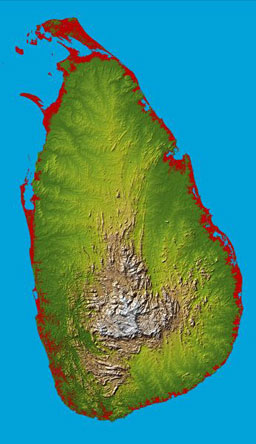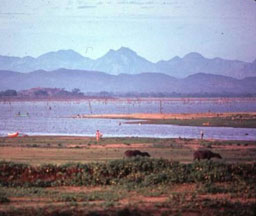Wildlife at Polonnaruwa
On a global scale, Sri Lanka has been declared as one of the world’s 25 different hotspots in biodiversity . . .
. . and the kings at Polonnaruwa had promoted nature protection since the 12 century AD

At Sri Lanka’s ancient capital of Polonnaruwa, King Nissankamalla (1187-96) inscribed the following message on stone pillars (translated from ancient Sinhalese): “Security is granted to all animals in the dominion of 3 provinces“ (Epigraphica Zeylonica Vol 2,#23)
 Wildlife of Sri Lanka
Wildlife of Sri Lanka
[Sri Lanka Map] Sri Lanka has been declared a biodiversity hotspot on a global scale. Much of this biodiversity is attributable to its island form, harboring many endemic species, and to its variable topography and climate. The island has an area of about 65,000 sq km (430 km long and 230 across at its widest point), lying approximately 6o and 9o north of the equator. The center of the island is formed by rugged highlands whose peaks reach up to 2,524 m. Frost (but not snow) may form in the hills in winter and contrasts the hot steamy to arid lowlands. Rain is carried to the island from the surrounding seas by two major air-currents active from May to September (South-West monsoon) and October to January (North-East monsoon). This combination has contributed to the formation of several different ecological zones: lowland rainforest (south-west), highland rainforest (central hills), montane cloud forests (central mountains), lowland dry semi-evergreen forest (south-east, eastern and northern lowland), lowland arid scrub forest (extreme northwest and south east), and intermediate gradient types. Travelers can traverse several of these zones within a day.
Although most of Sri Lanka’s plants and animals have been derived from the Indian subcontinent, the island also has one of the highest rates of biological endemism (16% of the fauna and 23% of flowering plants are endemic). Endemics prevail especially in the isolated central mountains. In addition, many animals have evolved distinct differences in anatomy as adaptations to the local conditions. Animal populations with consistent morphological differences among ecological zones within the same species are categorized as sub-species. Among the 5 species of primates, for example, there are 13 distinct subspecies. Although Sri Lanka occupies less than 1.5% of the land area of South Asia, it is host to 30% (13/43) of primate subspecies in the region. Sri Lanka has the greatest diversity of primates in South Asia.
The area in and around our study site at Polonnruwa is representative biologically of the extensive lowland northern and eastern dry-zone that originally was blanketed by dry semi-evergreen forest. The diversity (tree species composition) of this natural forest cover varies markedly with rainfall (more, see Publications: Dittus 1977, 1985). Our study site at Polonnaruwa is fairly representative of the richer and moister part of this zone. Two of the primates here are endemic (found only in Sri Lanka), the Toque macaque and Purple-faced langur. Among birds, 9 endemic species are found in our area.

